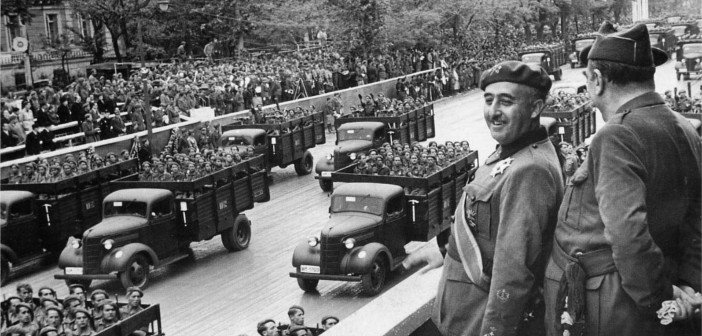Forty years on, Spain’s Franco still divides the country
The great celebration took place 40 years ago, in the winter of 1975. And across Spain the occasion was the death, after a lingering illness, of the diminutive dictator who had changed the face of the country: Francisco Franco Bahamonde.
That quote, a common comment on the night by the legions of anti-Francoists, is from Ian Gibson, self-described Irishman reinvented as a Spaniard, in his book and television series of 1992, Fire in the Blood.
There’s little doubt that Franco’s passing was a source of great joy and relief to many of his countrymen; but in his more measured account, Franco’s biographer Paul Preston notes that haberdashers also soon ran out of black material for armbands, and quotes a Spanish writer’s description of the dignified silence in Barcelona: ”throughout 20 November 1975, the city filled with silent passers-by… their throats dried by prudent silence”. In Franco’s Spain, it had often been wise to be paranoid.
According to London’s Daily Telegraph, plans for Franco commemorative masses across Spain have sparked bitter discord, especially from the Association for the Recovery of Historical Memory. On December 3, a dinner was held in a Madrid hotel, to celebrate the 123rd anniversary of the birth of the man known as “El Caudillo”. This was organised by the Francisco Franco Foundation, on the other side of the argument from the Historical Memory Association. Their difference marks a split in Spain, which has been fed by the rise of rightist, Fascist-inspired parties across Europe. For years it was often assumed, externally, that the Franco years were a grim period for all Spain, and the military dictator malign. But those who supported him have become increasingly vocal, and Spain’s recent economic difficulties seem to have accentuated their feeling.
The Association for the Recovery of Historical Memory’s core aim is to recover the remains of the many who still lie beneath the soil of Spain – perhaps the best known is the poet Federico Garcia Lorca, executed early in the conflict, who has never been found despite heart-rending attempts. The Association more broadly also seeks, it says, to put in context the actions, policy, and cruelty of Franco which some argue stunted a brilliant society.
It is one of the running themes of Jeremy Treglown’s recent book, Franco’s Crypt: Spanish Culture and Memory Since 1936, which examines whether the commonly held beliefs about Franco’s rule hold up under retrospective analysis. There is a simple reason for the prevailing idea that Franco was a Philistine who suppressed the arts, partly through his censorship and restrictions on free speech, during his four decades of power.
Treglown, though, fair-minded and thorough, argues that there was creative acitivy, especially in literature and theatre, a fact that the Left prefers to ignore or condemn. He is here taking – tentative- steps into the furious debate that has riven Spain for decades. One of Treglown’s points is that there remains a strain of opinion in Spain that Franco was not the evil demagogue. Events show that as in nearly all European countries, a far right faction exists and its members often identify with Franco, the successful, uncompromising Caudillo (“leader”).
Franco died on November 20, 1975. He was and had been ill for months, with doctors trying everything, even leeches, to keep the old man alive. In 2007, under the Socialist government of Jose Rodriguez Zapatero, a law was enacted requiring local authorities to take down monuments and plaques to Franco. There are pockets of resistance still, such as the Moncloa Victory Arch in Madrid; or a plaque, on a building in the south-western town of Caceres, one of the strongholds of the Francoist cohort – and centuries before, of the original Conquistadors.
Irish author, historian and environmentalist, Paddy Woodworth, who was teaching in Spain at the time, writes:
“Franco’s miserably prolonged death agony obsessed both his supporters and his opponents. Some of us wondered unkindly why such a devout Catholic as the dictator should cling to his mortal existence with such tenacity.
This was, after all, a man who had summarily dispatched uncounted others to early graves throughout his long career. Notoriously, he used to sign sheaves of death warrants nightly over dinner, while leading the 1936-39 insurrection against Spanish democracy that led to his 40-year dictatorship. And only weeks before he died he had ignored clemency pleas from the pope and the EEC, and insisted on executing five members of armed opposition groups, including two from the Eta.”
In a dark coincidence, November 20 is also the anniversary of the death of Jose Primo de Rivera, founder of the right-wing Falange movement. But Primo de Rivera did not die in his bed, but was shot by the Republican Left in 1936, during the terrible civil war that brought Franco to power.
Featured Images:
thepeninsulaqatar.com
tumblr.com

